Applying technology combining with “Flipped learning” approach in teaching with academic credit-based training system in A1 English department
Since the twenty-fourth course, (academic year of 2019-2020) Hanoi
University of Business and Technology has changed their education training system
from academic year-based training system into academic credit-based training
system. The policy has required all the training departments, including English
departments, of Hanoi University of Business and Technology to redesign their
curriculums, syllabuses and teaching contents in order to meet all the requirements
of the university and the MOET.
The article has proposed to apply one of the pedagogical approaches which is
suitable for academic credit-based training system in the A1 English Department, the
Flipped Learning approach.
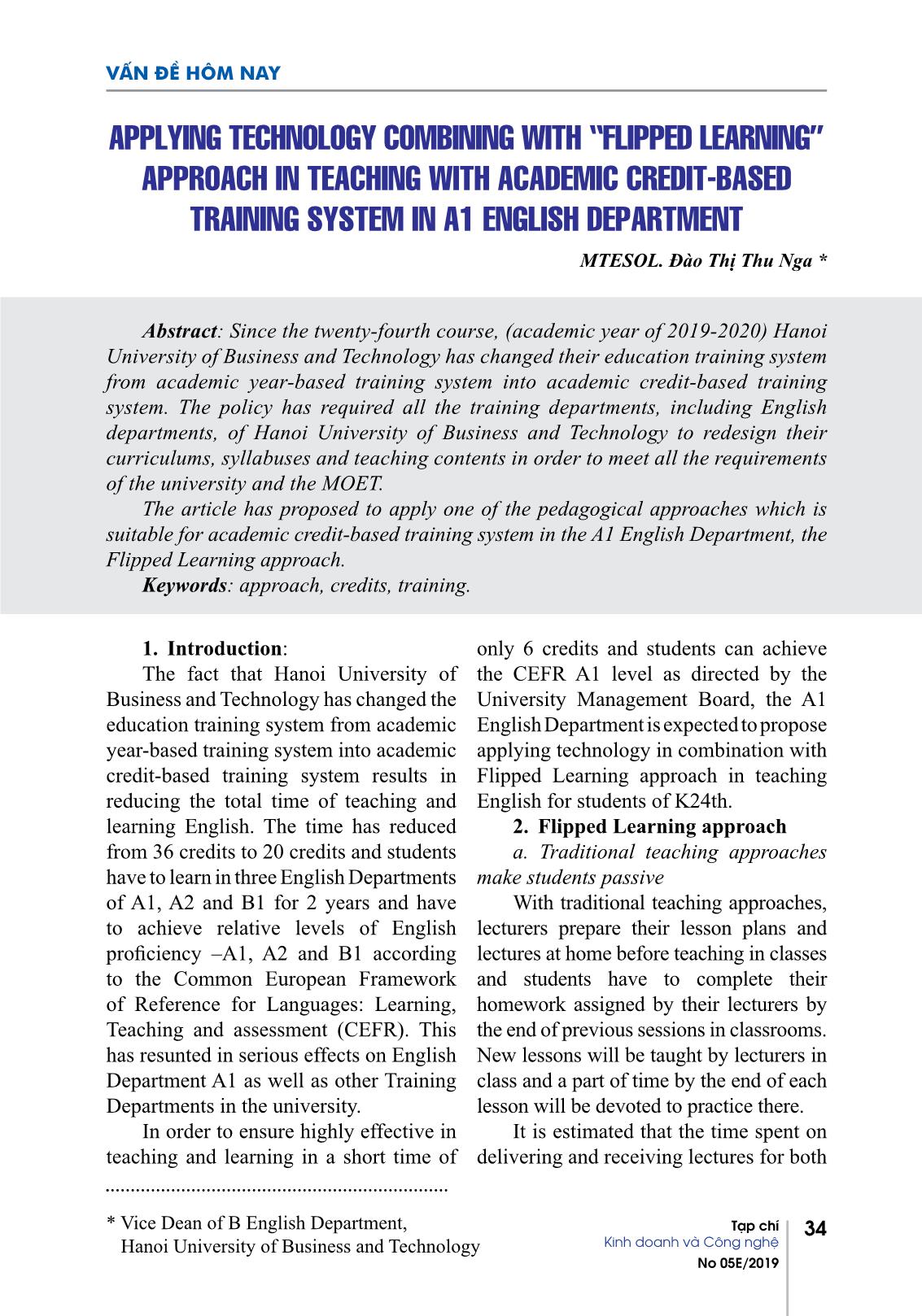
Trang 1
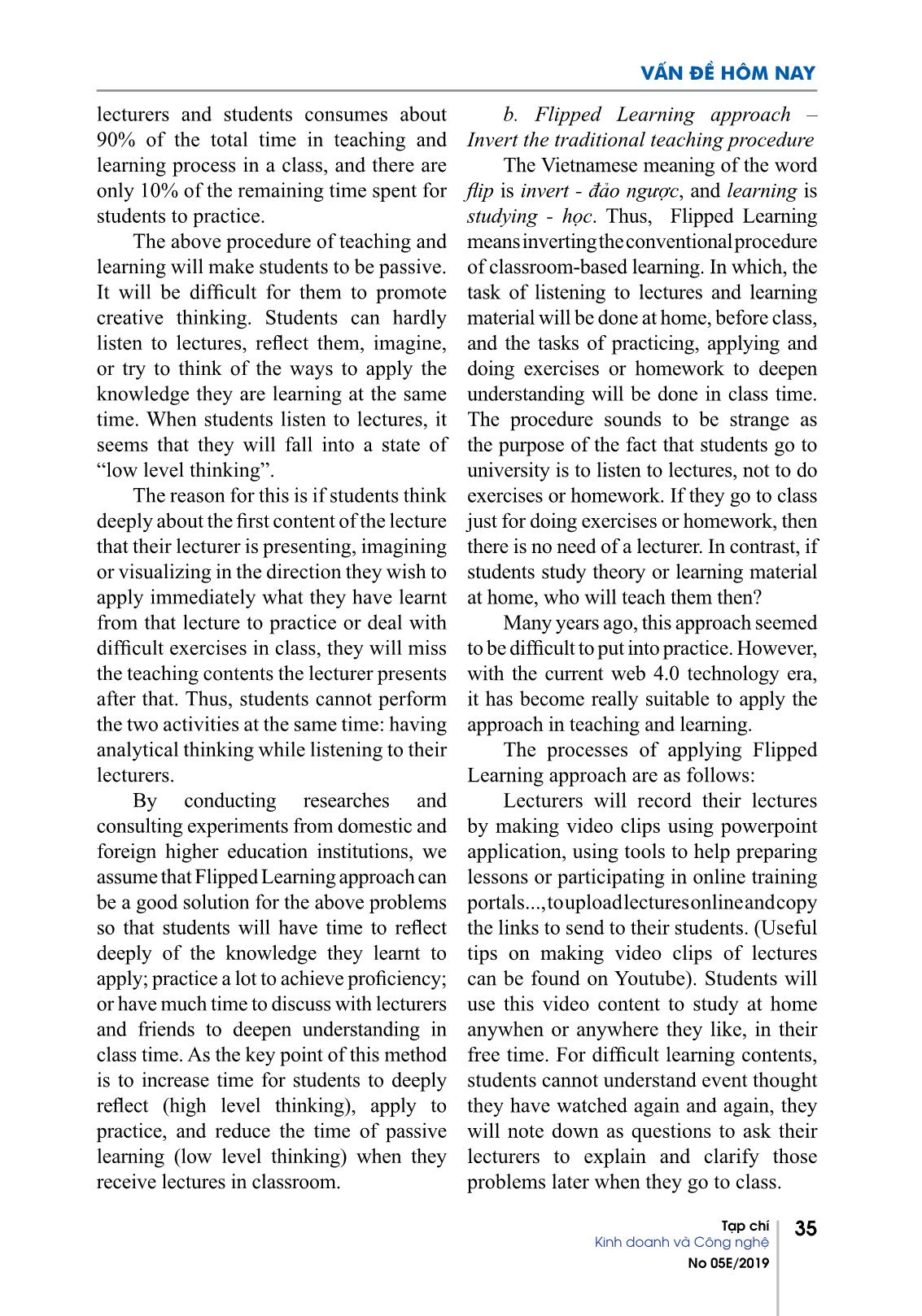
Trang 2
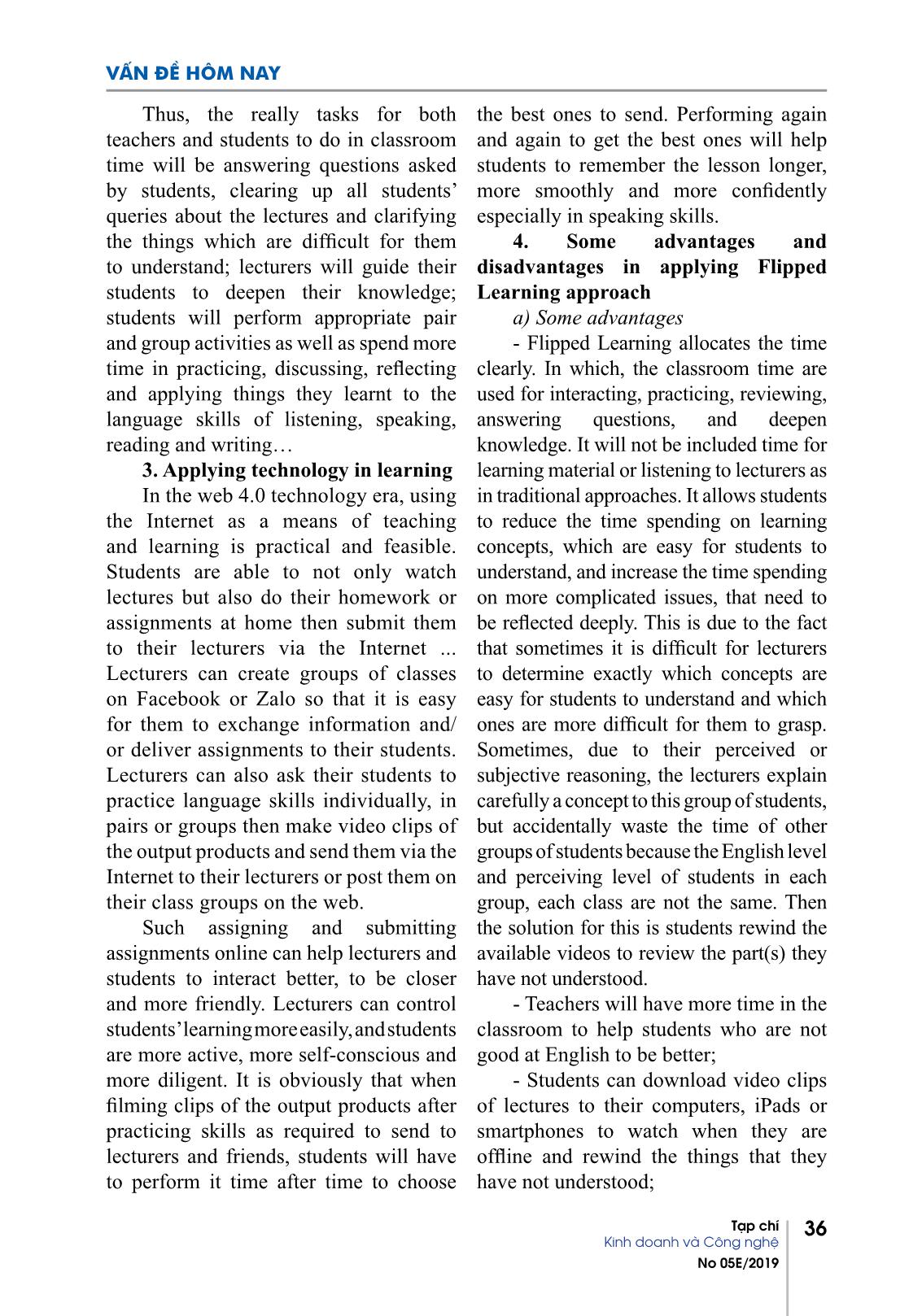
Trang 3
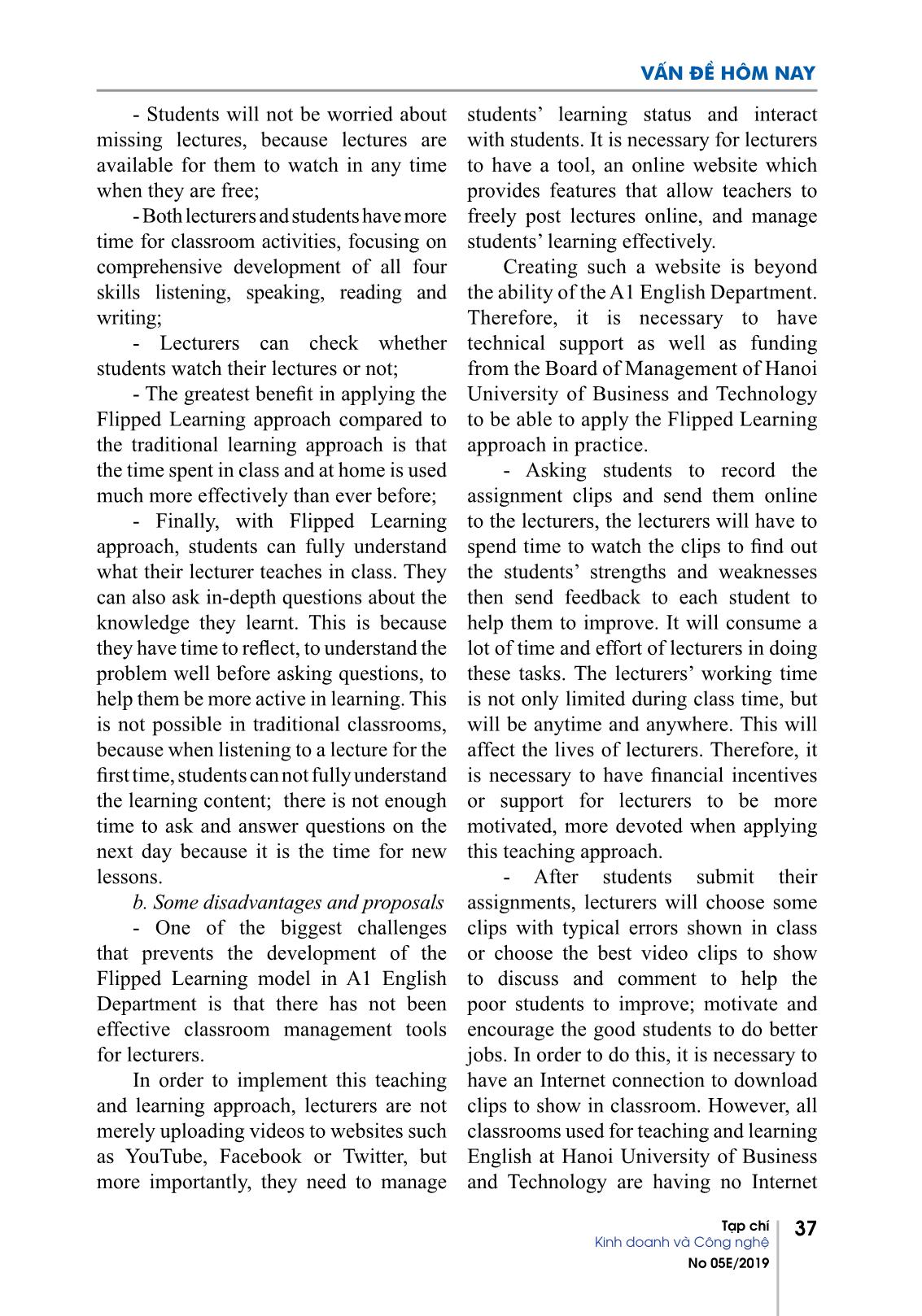
Trang 4
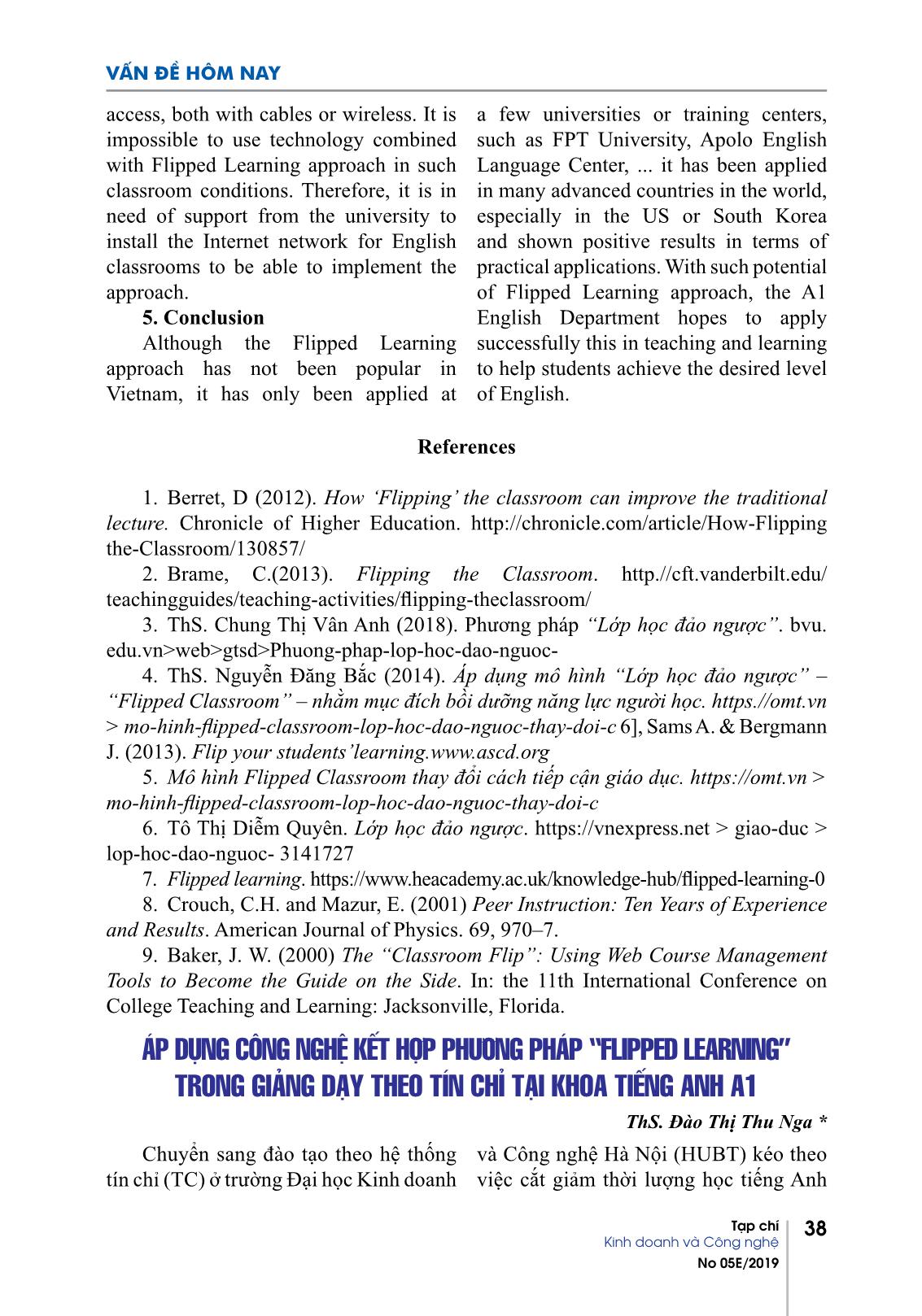
Trang 5
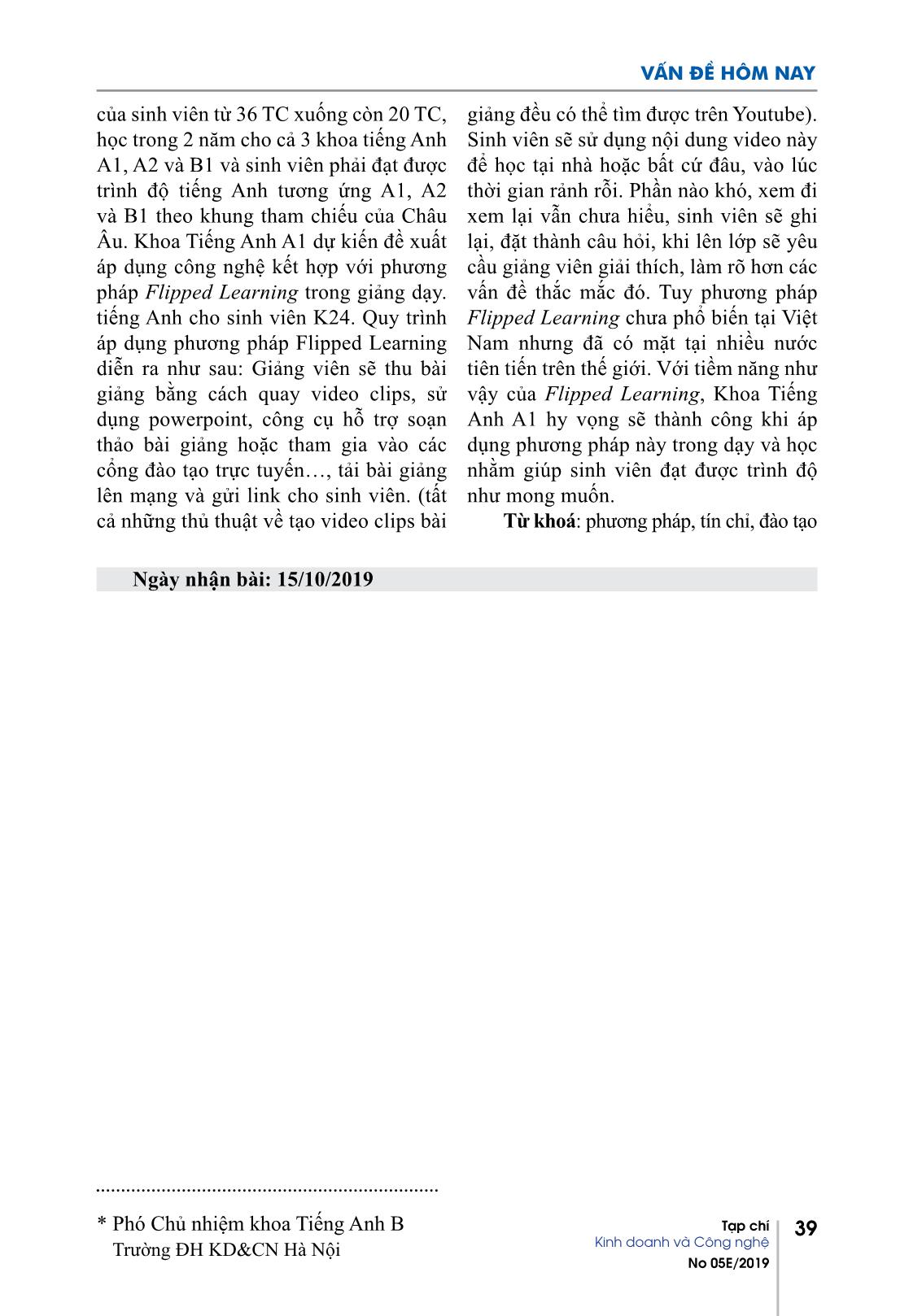
Trang 6
Bạn đang xem tài liệu "Applying technology combining with “Flipped learning” approach in teaching with academic credit-based training system in A1 English department", để tải tài liệu gốc về máy hãy click vào nút Download ở trên
Tóm tắt nội dung tài liệu: Applying technology combining with “Flipped learning” approach in teaching with academic credit-based training system in A1 English department
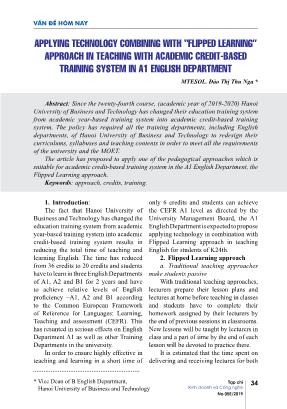
s, training. * Vice Dean of B English Department, Hanoi University of Business and Technology VẤN ĐỀ HÔM NAY 35Tạp chí Kinh doanh và Công nghệ No 05E/2019 lecturers and students consumes about 90% of the total time in teaching and learning process in a class, and there are only 10% of the remaining time spent for students to practice. The above procedure of teaching and learning will make students to be passive. It will be difficult for them to promote creative thinking. Students can hardly listen to lectures, reflect them, imagine, or try to think of the ways to apply the knowledge they are learning at the same time. When students listen to lectures, it seems that they will fall into a state of “low level thinking”. The reason for this is if students think deeply about the first content of the lecture that their lecturer is presenting, imagining or visualizing in the direction they wish to apply immediately what they have learnt from that lecture to practice or deal with difficult exercises in class, they will miss the teaching contents the lecturer presents after that. Thus, students cannot perform the two activities at the same time: having analytical thinking while listening to their lecturers. By conducting researches and consulting experiments from domestic and foreign higher education institutions, we assume that Flipped Learning approach can be a good solution for the above problems so that students will have time to reflect deeply of the knowledge they learnt to apply; practice a lot to achieve proficiency; or have much time to discuss with lecturers and friends to deepen understanding in class time. As the key point of this method is to increase time for students to deeply reflect (high level thinking), apply to practice, and reduce the time of passive learning (low level thinking) when they receive lectures in classroom. b. Flipped Learning approach – Invert the traditional teaching procedure The Vietnamese meaning of the word flip is invert - đảo ngược, and learning is studying - học. Thus, Flipped Learning means inverting the conventional procedure of classroom-based learning. In which, the task of listening to lectures and learning material will be done at home, before class, and the tasks of practicing, applying and doing exercises or homework to deepen understanding will be done in class time. The procedure sounds to be strange as the purpose of the fact that students go to university is to listen to lectures, not to do exercises or homework. If they go to class just for doing exercises or homework, then there is no need of a lecturer. In contrast, if students study theory or learning material at home, who will teach them then? Many years ago, this approach seemed to be difficult to put into practice. However, with the current web 4.0 technology era, it has become really suitable to apply the approach in teaching and learning. The processes of applying Flipped Learning approach are as follows: Lecturers will record their lectures by making video clips using powerpoint application, using tools to help preparing lessons or participating in online training portals..., to upload lectures online and copy the links to send to their students. (Useful tips on making video clips of lectures can be found on Youtube). Students will use this video content to study at home anywhen or anywhere they like, in their free time. For difficult learning contents, students cannot understand event thought they have watched again and again, they will note down as questions to ask their lecturers to explain and clarify those problems later when they go to class. VẤN ĐỀ HÔM NAY 36Tạp chí Kinh doanh và Công nghệ No 05E/2019 Thus, the really tasks for both teachers and students to do in classroom time will be answering questions asked by students, clearing up all students’ queries about the lectures and clarifying the things which are difficult for them to understand; lecturers will guide their students to deepen their knowledge; students will perform appropriate pair and group activities as well as spend more time in practicing, discussing, reflecting and applying things they learnt to the language skills of listening, speaking, reading and writing 3. Applying technology in learning In the web 4.0 technology era, using the Internet as a means of teaching and learning is practical and feasible. Students are able to not only watch lectures but also do their homework or assignments at home then submit them to their lecturers via the Internet ... Lecturers can create groups of classes on Facebook or Zalo so that it is easy for them to exchange information and/ or deliver assignments to their students. Lecturers can also ask their students to practice language skills individually, in pairs or groups then make video clips of the output products and send them via the Internet to their lecturers or post them on their class groups on the web. Such assigning and submitting assignments online can help lecturers and students to interact better, to be closer and more friendly. Lecturers can control students’ learning more easily, and students are more active, more self-conscious and more diligent. It is obviously that when filming clips of the output products after practicing skills as required to send to lecturers and friends, students will have to perform it time after time to choose the best ones to send. Performing again and again to get the best ones will help students to remember the lesson longer, more smoothly and more confidently especially in speaking skills. 4. Some advantages and disadvantages in applying Flipped Learning approach a) Some advantages - Flipped Learning allocates the time clearly. In which, the classroom time are used for interacting, practicing, reviewing, answering questions, and deepen knowledge. It will not be included time for learning material or listening to lecturers as in traditional approaches. It allows students to reduce the time spending on learning concepts, which are easy for students to understand, and increase the time spending on more complicated issues, that need to be reflected deeply. This is due to the fact that sometimes it is difficult for lecturers to determine exactly which concepts are easy for students to understand and which ones are more difficult for them to grasp. Sometimes, due to their perceived or subjective reasoning, the lecturers explain carefully a concept to this group of students, but accidentally waste the time of other groups of students because the English level and perceiving level of students in each group, each class are not the same. Then the solution for this is students rewind the available videos to review the part(s) they have not understood. - Teachers will have more time in the classroom to help students who are not good at English to be better; - Students can download video clips of lectures to their computers, iPads or smartphones to watch when they are offline and rewind the things that they have not understood; VẤN ĐỀ HÔM NAY 37Tạp chí Kinh doanh và Công nghệ No 05E/2019 - Students will not be worried about missing lectures, because lectures are available for them to watch in any time when they are free; - Both lecturers and students have more time for classroom activities, focusing on comprehensive development of all four skills listening, speaking, reading and writing; - Lecturers can check whether students watch their lectures or not; - The greatest benefit in applying the Flipped Learning approach compared to the traditional learning approach is that the time spent in class and at home is used much more effectively than ever before; - Finally, with Flipped Learning approach, students can fully understand what their lecturer teaches in class. They can also ask in-depth questions about the knowledge they learnt. This is because they have time to reflect, to understand the problem well before asking questions, to help them be more active in learning. This is not possible in traditional classrooms, because when listening to a lecture for the first time, students can not fully understand the learning content; there is not enough time to ask and answer questions on the next day because it is the time for new lessons. b. Some disadvantages and proposals - One of the biggest challenges that prevents the development of the Flipped Learning model in A1 English Department is that there has not been effective classroom management tools for lecturers. In order to implement this teaching and learning approach, lecturers are not merely uploading videos to websites such as YouTube, Facebook or Twitter, but more importantly, they need to manage students’ learning status and interact with students. It is necessary for lecturers to have a tool, an online website which provides features that allow teachers to freely post lectures online, and manage students’ learning effectively. Creating such a website is beyond the ability of the A1 English Department. Therefore, it is necessary to have technical support as well as funding from the Board of Management of Hanoi University of Business and Technology to be able to apply the Flipped Learning approach in practice. - Asking students to record the assignment clips and send them online to the lecturers, the lecturers will have to spend time to watch the clips to find out the students’ strengths and weaknesses then send feedback to each student to help them to improve. It will consume a lot of time and effort of lecturers in doing these tasks. The lecturers’ working time is not only limited during class time, but will be anytime and anywhere. This will affect the lives of lecturers. Therefore, it is necessary to have financial incentives or support for lecturers to be more motivated, more devoted when applying this teaching approach. - After students submit their assignments, lecturers will choose some clips with typical errors shown in class or choose the best video clips to show to discuss and comment to help the poor students to improve; motivate and encourage the good students to do better jobs. In order to do this, it is necessary to have an Internet connection to download clips to show in classroom. However, all classrooms used for teaching and learning English at Hanoi University of Business and Technology are having no Internet VẤN ĐỀ HÔM NAY 38Tạp chí Kinh doanh và Công nghệ No 05E/2019 access, both with cables or wireless. It is impossible to use technology combined with Flipped Learning approach in such classroom conditions. Therefore, it is in need of support from the university to install the Internet network for English classrooms to be able to implement the approach. 5. Conclusion Although the Flipped Learning approach has not been popular in Vietnam, it has only been applied at a few universities or training centers, such as FPT University, Apolo English Language Center, ... it has been applied in many advanced countries in the world, especially in the US or South Korea and shown positive results in terms of practical applications. With such potential of Flipped Learning approach, the A1 English Department hopes to apply successfully this in teaching and learning to help students achieve the desired level of English. References 1. Berret, D (2012). How ‘Flipping’ the classroom can improve the traditional lecture. Chronicle of Higher Education. the-Classroom/130857/ 2. Brame, C.(2013). Flipping the Classroom. http.//cft.vanderbilt.edu/ teachingguides/teaching-activities/flipping-theclassroom/ 3. ThS. Chung Thị Vân Anh (2018). Phương pháp “Lớp học đảo ngược”. bvu. edu.vn>web>gtsd>Phuong-phap-lop-hoc-dao-nguoc- 4. ThS. Nguyễn Đăng Bắc (2014). Áp dụng mô hình “Lớp học đảo ngược” – “Flipped Classroom” – nhằm mục đích bồi dưỡng năng lực người học. https.//omt.vn > mo-hinh-flipped-classroom-lop-hoc-dao-nguoc-thay-doi-c 6], Sams A. & Bergmann J. (2013). Flip your students’learning.www.ascd.org 5. Mô hình Flipped Classroom thay đổi cách tiếp cận giáo dục. https://omt.vn > mo-hinh-flipped-classroom-lop-hoc-dao-nguoc-thay-doi-c 6. Tô Thị Diễm Quyên. Lớp học đảo ngược. https://vnexpress.net > giao-duc > lop-hoc-dao-nguoc- 3141727 7. Flipped learning. https://www.heacademy.ac.uk/knowledge-hub/flipped-learning-0 8. Crouch, C.H. and Mazur, E. (2001) Peer Instruction: Ten Years of Experience and Results. American Journal of Physics. 69, 970–7. 9. Baker, J. W. (2000) The “Classroom Flip”: Using Web Course Management Tools to Become the Guide on the Side. In: the 11th International Conference on College Teaching and Learning: Jacksonville, Florida. ÁP DỤNG CÔNG NGHỆ KẾT HỢP PHƯƠNG PHÁP “FLIPPED LEARNING” TRONG GIẢNG DẠY THEO TÍN CHỈ TẠI KHOA TIẾNG ANH A1 ThS. Đào Thị Thu Nga * Chuyển sang đào tạo theo hệ thống tín chỉ (TC) ở trường Đại học Kinh doanh và Công nghệ Hà Nội (HUBT) kéo theo việc cắt giảm thời lượng học tiếng Anh VẤN ĐỀ HÔM NAY 39Tạp chí Kinh doanh và Công nghệ No 05E/2019 * Phó Chủ nhiệm khoa Tiếng Anh B Trường ĐH KD&CN Hà Nội Ngày nhận bài: 15/10/2019 của sinh viên từ 36 TC xuống còn 20 TC, học trong 2 năm cho cả 3 khoa tiếng Anh A1, A2 và B1 và sinh viên phải đạt được trình độ tiếng Anh tương ứng A1, A2 và B1 theo khung tham chiếu của Châu Âu. Khoa Tiếng Anh A1 dự kiến đề xuất áp dụng công nghệ kết hợp với phương pháp Flipped Learning trong giảng dạy. tiếng Anh cho sinh viên K24. Quy trình áp dụng phương pháp Flipped Learning diễn ra như sau: Giảng viên sẽ thu bài giảng bằng cách quay video clips, sử dụng powerpoint, công cụ hỗ trợ soạn thảo bài giảng hoặc tham gia vào các cổng đào tạo trực tuyến, tải bài giảng lên mạng và gửi link cho sinh viên. (tất cả những thủ thuật về tạo video clips bài giảng đều có thể tìm được trên Youtube). Sinh viên sẽ sử dụng nội dung video này để học tại nhà hoặc bất cứ đâu, vào lúc thời gian rảnh rỗi. Phần nào khó, xem đi xem lại vẫn chưa hiểu, sinh viên sẽ ghi lại, đặt thành câu hỏi, khi lên lớp sẽ yêu cầu giảng viên giải thích, làm rõ hơn các vấn đề thắc mắc đó. Tuy phương pháp Flipped Learning chưa phổ biến tại Việt Nam nhưng đã có mặt tại nhiều nước tiên tiến trên thế giới. Với tiềm năng như vậy của Flipped Learning, Khoa Tiếng Anh A1 hy vọng sẽ thành công khi áp dụng phương pháp này trong dạy và học nhằm giúp sinh viên đạt được trình độ như mong muốn. Từ khoá: phương pháp, tín chỉ, đào tạo
File đính kèm:
 applying_technology_combining_with_flipped_learning_approach.pdf
applying_technology_combining_with_flipped_learning_approach.pdf

